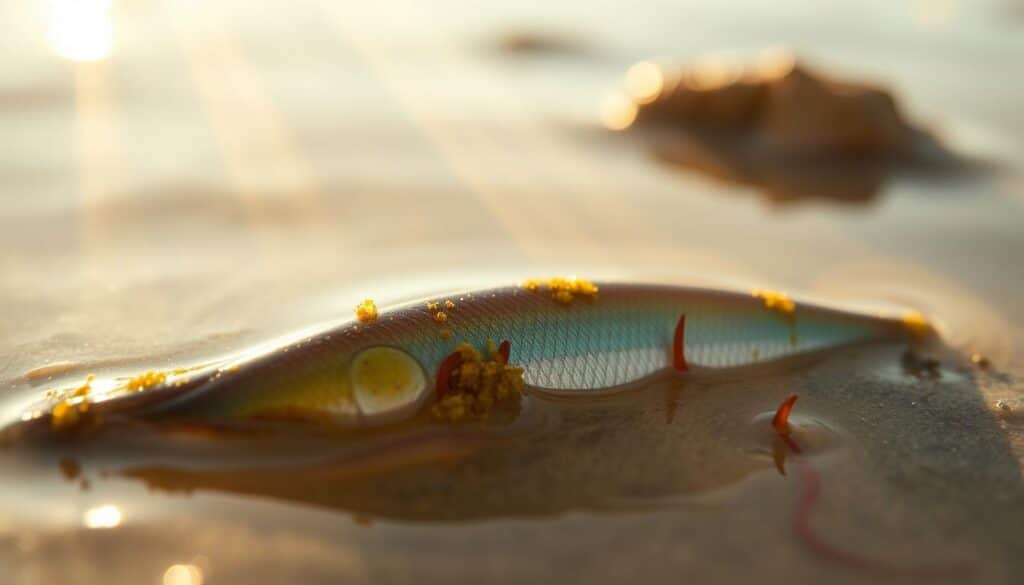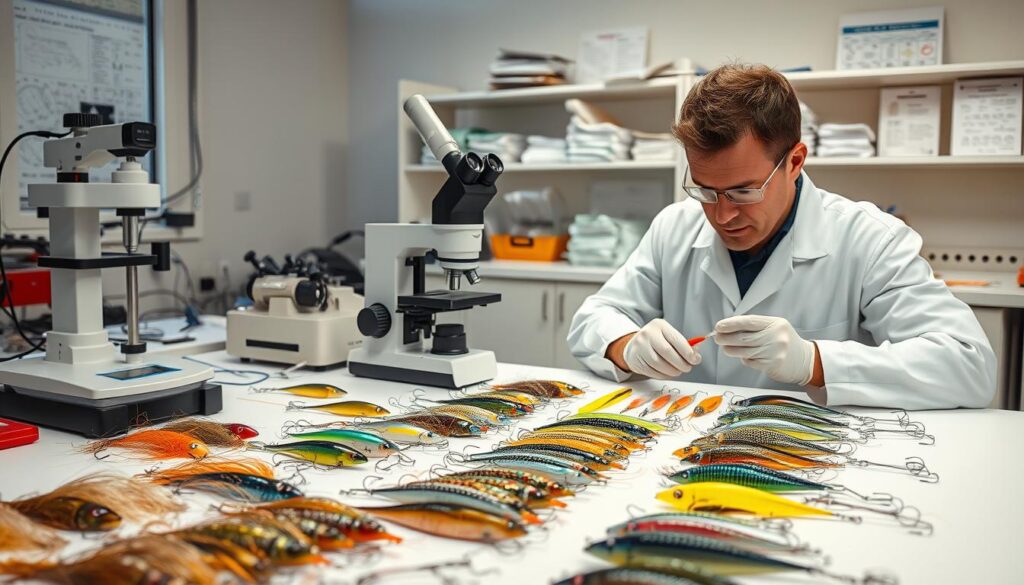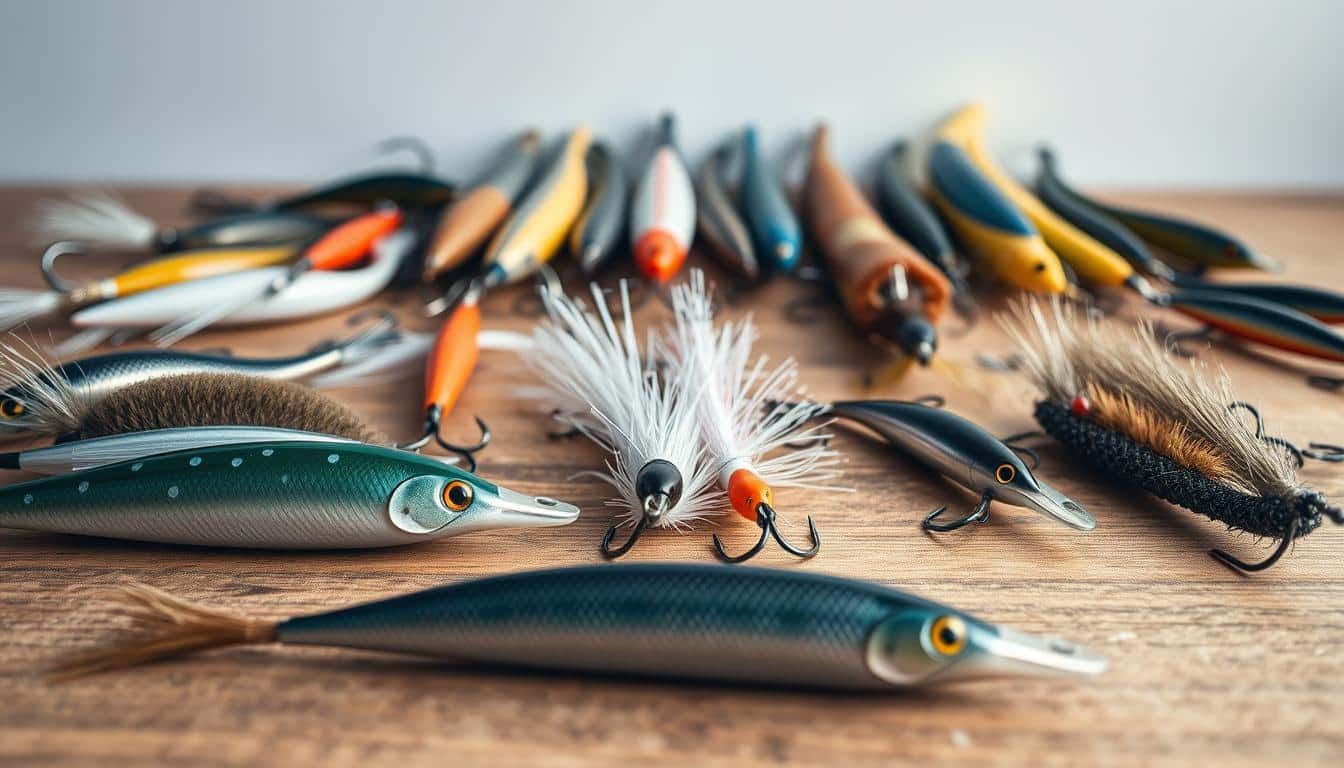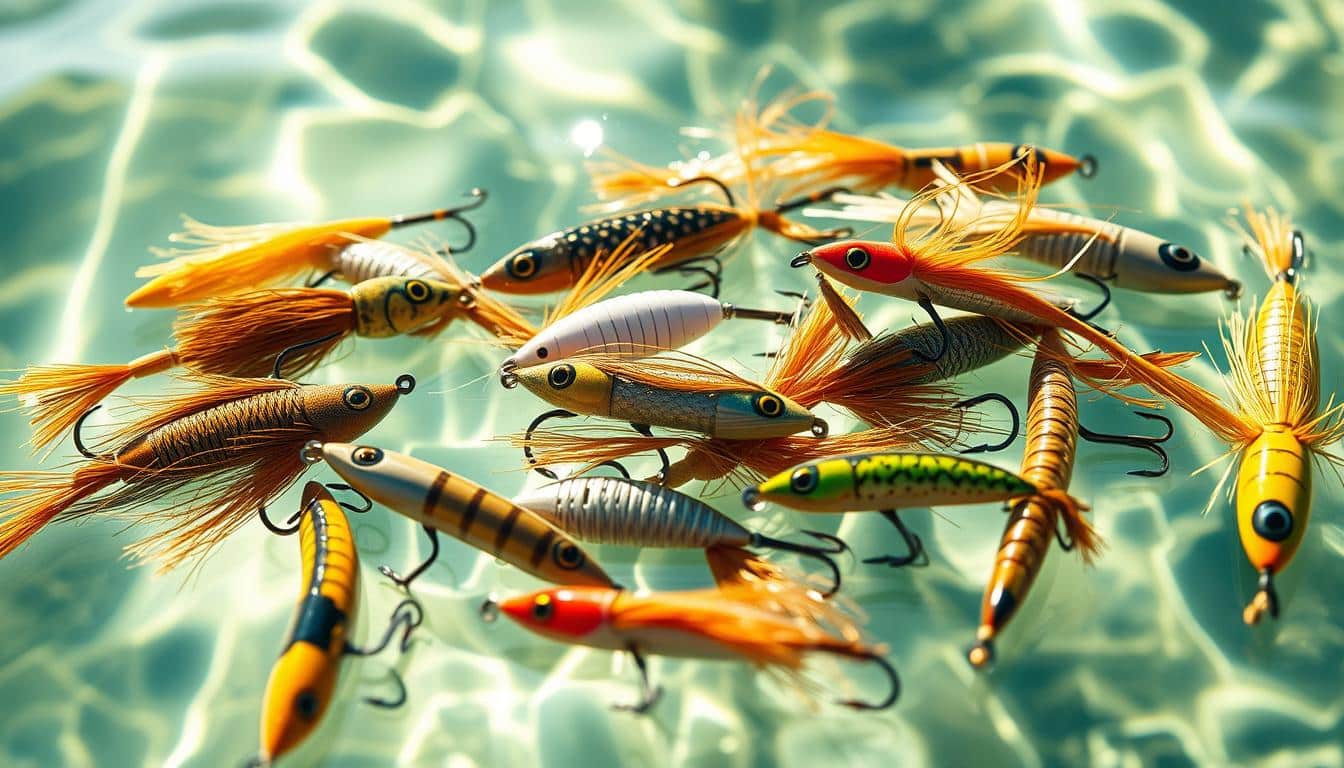Anglers across the U.S. are keen to find real plastic-free lures. We aim to guide you. Learn to distinguish true plastic-free fishing lures and eco-friendly tackle from the usual baits and misleading claims.
Plastic pollution in our waters is a serious problem. Places like Bayshore Boulevard in Tampa are littered with trash and discarded nets. Sadly, many marine animals suffer from ingesting fish lines and plastics. By choosing eco-friendly lures, we lessen the danger to marine life and protect fishing spots and our reputation as anglers.
Keep an eye on innovations like BPI-certified products which can fully degrade in weeks. Other products to look for include Berkley’s Gulp!, which takes longer to degrade, and new options like hemp-PLA mixes and water-soluble Biobait. There’s also tackle made from recycled ghost nets by Alternative Fishing Lures. This guide will help you identify trustworthy labels, perform simple tests, choose top brands, understand realistic degrading times, and maintain a tackle box that’s both effective and green.
Why plastic-free fishing tackle matters for anglers and waterways
Anglers want clean waters and lots of fish. But fishing pollution hurts both. Lines, lures, and nets left in water can last for years and damage wildlife homes.
Environmental impact of lost lures and tackle
Fishing lines made of monofilament, nylon, or polyester can last a long time. Scientists find bits of lines and nets inside sea animals. This mess can hurt fish, slow their growth, and make it hard for them to find food.
Cleansing efforts in places like Tampa Bay reveal nets and lures mixed with other trash. This lost gear doesn’t just look bad. It breaks down into tiny pieces that pollute our seas for a long time.
Regulatory and social pressure on recreational fishing
Government agencies are paying more attention to fishing waste. When people see how much gear is pulled from waters, they want stricter fishing laws. There’s a push for safer fishing gear and testing new lines that break down easier.
Retailers and gear makers are feeling the heat to come up with new ideas. Anglers who don’t follow the rules might face tough restrictions. Public opinion is changing fast, and it’s affecting what products are available.
Benefits to fisheries and angler reputation
Using gear that breaks down or doesn’t contain plastic helps the environment. This makes fishing spots healthier and fish populations stronger.
Cleaning up old gear and following rules makes fishing look good. Actions like these improve fishing’s image. Organizations like Keep America Fishing encourage good practices. This helps keep fishing spots open and affects fishing policies positively.
Common materials used in traditional lures and how to spot them
Anglers aiming for less harmful tackle should know what materials make up a lure. Most traditional crankbaits, swimbaits, and paddletails come from hard-to-break-down petroleum polymers. Learning to recognize these materials helps choose which lures to use or avoid.
Many hard plastic lures are made from PVC, ABS, or similar hard resins. These materials are tough, hold paint well, and keep water out. Yet, they don’t break down easily in nature. Take the Storm 360GT Searchbait as an example, which combines a PVC body with ABS parts in its jighead.
There are newer, more eco-friendly materials being used now. For instance, ElaZtech by Z-Man is a strong, less toxic alternative to PVC. A quick look at product descriptions or packaging for “ElaZtech” or “PVC-free” can show what the lure is made of.
Soft plastics formulation clues
Original soft plastic baits were made from vinyl plastisol. These early soft worms often feel slick, may leave a slight residue, and could have added scents. If a brand adds a lot of scent or uses oily pigments, it’s likely using the old plastisol formula.
Some brands are trying out PVOH and natural binders to lessen environmental impact. Berkley’s Gulp! and those using soy or hemp aim for better environmental breakdown. But, a bait smelling strongly of anise or another scent does not automatically mean it’s eco-friendly. Scents are just added ingredients, not an indicator of the base material.
Non-plastic components to check
The lure’s body isn’t the only part that affects the environment. Hooks, rings, rattles, eyes, and weights all pose risks too. Lead in jigheads is toxic, and rattles from metal or ABS last a long time in nature, outliving the soft parts of lures.
How lures behave in storage can also tell you what they’re made of. For example, ElaZtech lures might melt or change shape if they touch PVC plastisol lures. A reaction like this in a tackle box shows incompatible materials.
- Inspect the label for PVC, ABS, PVOH, or ElaZtech terms.
- Smell and feel can hint at plastisol-based soft plastics.
- Note metal vs. molded jigheads and whether weights contain lead.
How to Identify Truly Plastic-Free Lures
Finding truly plastic-free lures involves more effort than just a quick look at the label. You should seek out certifications, read material labels, and check if brands share their test results. This helps fishermen distinguish trustworthy products from those just pretending to be eco-friendly.
- Look for lures certified by the BPI if sellers claim they are compostable. The Biodegradable Products Institute checks materials against composting standards and lists certifications for products that pass.
- Search for ASTM-standard tests such as ASTM D6400 for compostability or ASTM D5511 for anaerobic biodegradation. Reports from independent labs that mention these standards provide better evidence than just claims made in advertising.
- Keep an eye out for brands that share details about test conditions and how long it takes for their products to degrade in fresh or saltwater. Be wary of products that only say “biodegradable” without backing it up with data.
Material labels anglers should recognize
- PVOH, or polyvinyl alcohol, is found in water-soluble or more easily degradable tackle. It’s different from PVC and breaks down more easily in water.
- ElaZtech is a non-PVC polymer used by Z-Man. It’s tough and lasts longer but isn’t automatically biodegradable. Labels help explain this.
- PLA and Hemp-PLA blends are used by some environmentally friendly prototypes and smaller producers. They can break down in industrial composting setups, so look for products with this certification.
- When you see “made from recycled ghost nets” or “100% recycled plastics,” it shows a commitment to sustainability. However, these claims do not mean the product is free of plastic.
Packaging and brand transparency
- Trust in brands that openly share information about their materials, lab findings, and how long it takes products to biodegrade. Detailed product pages often include test outcomes for various conditions and advice on how to store items.
- Companies with patents and a history in manufacturing are more likely to offer trustworthy technical information. Look for easy-to-download reports or certifications linked directly to their claims.
- Steer clear of sellers who are vague about their products or use general eco-friendly terms without specifics. Retailers that organize their products well and offer advice on storing them properly are more dependable.
Physical tests and inspection tips anglers can do in the field or at the shop
Before you buy, perform a few simple inspections on lures. This helps you understand the material without needing special tools. These quick checks can tell you if a bait is eco-friendly or made of common plastics like PVC or ABS. Always use samples or unwanted pieces for tests that might damage the lure.
Touch and flex tests
- Check the body and tail’s texture. ElaZtech and similar materials feel very soft and bounce back quickly. Plastisol, however, feels softer but may keep creases.
- Bend the tail back and forth. True elastomers will return to their original shape and resist tears. Plastisol can show permanent bending or become thin.
- Press on hard baits near the seam. Softer PVC might reveal flaws at the seam, but ABS or biopolymers seem tougher and more even.
Smell, heat sensitivity, and simple at-home checks
- Sniff the bait lightly. A sweet smell usually indicates added oils, not that it’s biodegradable.
- Do a quick heat test with an extra piece. Carefully warm a small part. Plastisol smells and looks different from PLA when heated.
- Test a rejected lure piece in warm water. Items made of PVOH will soften quicker than those made of PVC. Remember, never damage items for sale when testing.
Storage compatibility clues
- Store different materials separately. ElaZtech reacts with PVC plastisol, causing melting or stickiness, which shows they don’t mix well.
- Look at what manufactures say about how long their product lasts. Brands like Toray and TufLine provide useful info on durability.
- Pay attention to packaging and care info. Clear instructions usually mean the company is open about their materials and how to care for their products.
Brands and product types making credible plastic-free claims
A lot of brands are working to reduce plastic waste from fishing. Some are using materials that biodegrade, while others use plastic picked up from the ocean. Some even try making things from plants. Always read the label and look for proof before buying.
Certified biodegradable examples and industry innovators
- MHG is working on polymers that break down in freshwater in 8–12 weeks and is also working on options for saltwater. They’ve teamed up with Bill Lewis for a biodegradable version of Rat-L-Trap lures.
- Berkley Gulp! has developed baits that break down faster than usual, though it takes longer in saltwater. Their products are better for the environment but don’t have BPI certification.
- Biobait says its product can dissolve in water within a year. But, it’s smart to check this claim yourself before you trust it.
Recycled-plastic alternatives and ghost-net initiatives
- In Jacksonville, Florida, Alternative Fishing Lures makes items from 100% recycled plastics from the ocean. They tell you exactly what’s in them and that they don’t use lead.
- Some gear is made from old fishing nets pulled from the sea. This helps by using less new plastic, but it’s still not perfect.
Products to approach with caution
- Hemp lures may be the next big thing. But, make sure they really break down in water, not just in compost. Companies like Jenko are testing products like this.
- Be careful with DIY kits and some “biodegradable” lines. Always ask for proof to make sure they are as eco-friendly as they say.
- Some products didn’t make it in the market, which shows there can be issues. TufLine claims to have a degradable line, but check if it really works as advertised.
When you’re picking out new fishing gear, compare real test results. Look for items with proof from labs or certs. This can help you tell real eco-friendly products from just talk.
Understanding biodegradability claims and realistic timelines
Manufacturers’ words can mean different things in real life. Anglers should be careful when reading labels. They must understand the limits of lab tests when looking at biodegradable versus compostable options. Knowing these details helps set true expectations for when lures get lost or thrown away.

Differences you need to know
- Biodegradable: gets broken down by tiny life forms into water, carbon dioxide, and new natural material over time. How quickly this happens can change depending on the material and where it is.
- Compostable: made to break down in special conditions found in industrial compost facilities within a specific period, following standards like ASTM D6400.
- Water-soluble: certain materials can dissolve in water. But dissolving is not the same as completely turning into natural elements; some leftovers and chemicals might still be around.
Typical timeframes and real-world claims
Companies offer different numbers on how fast their products break down. For instance, some lures certified by BPI can turn into natural elements in 8–12 weeks under testing conditions. Others, especially some bait brands, might take up to two years to break down in the ocean. They might break down faster in landfills or compost setups.
- Just because something breaks down fast in industrial compost doesn’t mean it will do the same in the ocean or lakes.
- Using recycled-plastic lures won’t break down quickly but helps reduce the need for new plastic. They last for decades.
Saltwater versus freshwater expectations
Saltwater makes lures break down slower and differently due to its saltiness, temperature, and unique marine life. Anglers should expect lures to last longer if lost in the ocean.
Certain lures break down faster in lakes according to manufacturers. But, saltwater versions can act differently. Trusting independent tests and reports is wise to verify these claims.
Practical takeaways
- Always ask for proof like certified tests if a product says it’s compostable or biodegradable.
- The time it takes for a lure to break down depends on where it is and its make-up.
- Choose products with clear testing info, especially if you’re worried about saltwater lure degradation.
Practical angler choices: how to transition toward lower-impact tackle
Start by taking small steps toward lower-impact tackle. Choose situations where you often lose gear to test new alternatives. This way, you can get used to new materials without needing to replace everything at once.
When to choose biodegradable or recycled lures
- For areas with lots of structures or during competitions, use biodegradable lures. Look for ones that have passed tests like MHG to ensure they’re safe.
- Pick lures made from recycled ghost nets for durable use and to help clean oceans. Brands using reclaimed materials offer lures that perform well and reduce ocean waste.
- Consider lures made from hemp-PLA or PVOH if they’re proven to break down in water. Choose products with lab results to know they’re safe in both salt and fresh water.
Proper disposal and lost-lure prevention
- Dispose of fishing line and tackle properly. Use recycling bins for lines and join clean-up efforts to protect wildlife.
- Use techniques to avoid snags and learn the best knots. Use lines and leaders designed to break down in nature in risky areas.
- Keep different types of lures separate. For example, make sure ElaZtech and PVC lures don’t mix. Always take back what you bring, never throw old gear in the water.
Balancing performance, cost, and sustainability
- Recycled or biodegradable gear might cost more. But, think about the benefits like less cleaning up and helping the environment.
- Try out new gear in local waters first. Many anglers find that the eco-friendly lures work just as well as regular ones.
- Keep using your usual gear in areas where you rarely lose lures. Start using more eco-friendly options in places where gear loss is common. This helps you save money while being more eco-conscious.
Every small choice makes a difference. Follow these tips to make your fishing more environmentally friendly. Gradually switch to sustainable gear to keep our waters clean and help wildlife.
How manufacturers test and certify lure materials
Manufacturers check lure quality through lab experiments and real-world testing. They share detailed reports on their testing methods, results, and time taken. This lets fishermen know which products are reliable. Easy-to-understand lab data and independent certifications help in choosing the right fishing gear.

Typical lab tests and field trials
- Labs use specific methods to test how lures break down. They perform ASTM biodegradation tests, including tests in industrial compost and without oxygen. The tests look at how much of the lure is left, how much CO2 it creates, and what remains after testing.
- In real-life conditions, lures are tested in both freshwater and saltwater. These tests examine how well lures hold up, if they still attract fish, if the rattle works, and if they remain strong after many uses.
- Manufacturers must explain where and how they test their lures, including the test conditions and duration. Without these details, it’s tough to believe their claims.
What patents and company transparency indicate
- When a company has patents for biodegradable materials, it means they’re constantly creating new things. Companies that share their patents generally provide more detailed information for customers to review.
- A company’s openness is shown through shared test results, certifications from others, and being honest about product limitations. This includes differences in how products last in saltwater versus freshwater and their shelf life.
- Learning from past failures is key. Responsible manufacturers talk about potential issues like how well a lure resists the sun, knot strength, and overall durability from the start.
Questions to ask before you buy
- Is the product certified by an outside party? Find out who did the tests and which standards were used.
- Ask if they did degradation tests in the lab, freshwater, saltwater, or industrial compost. Ask for the methods used and the findings.
- How long will the lure last while sealed and after it’s been used? Ask for any data on how it holds up over time.
- Find out if parts of the lure are biodegradable, can be recycled, or are permanent. Make sure the hooks, weights, eyes, and rattles are as stated.
- Ask if the company can show lab reports, patents, or independent studies on how well the lures work.
Having clear information helps anglers choose lures based on performance and how they affect the environment. Thorough testing of lure materials and openness from manufacturers make it simpler to pick trustworthy products.
Conclusion
Identifying truly plastic-free lures begins with simple habits. Always read labels and look for certification marks like BPI and ASTM. Perform checks by feeling the lure and seeing how it’s stored. Choose brands known for transparency, such as MHG, Berkley, and Alternative Fishing Lures. These steps guide anglers toward fishing responsibly without compromising the quality of their tackle. A quick check while shopping or fishing can show if a lure is probably biodegradable or just an eco-friendly claim.
Biodegradable labels mean different things. MHG products may meet strict lab standards with a BPI certification. Berkley Gulp! lures, however, break down over months or years, and this depends on the environment. Since saltwater and cold can slow down the process, knowing what to expect helps make better choices for eco-friendly fishing gear.
Doing our part is important. Join in on cleaning up shores, and always throw away used lines and lures correctly. Support products that have a low impact on the environment. Try out new lures in local waters and ask the makers about their eco-certifications and tests. This connects good fishing performance with caring for the environment. By adopting these habits, sustainable fishing becomes more than a catchy phrase. It becomes a way of life that keeps our waterways clean and fishing accessible for everyone in the future.
FAQ
What are the first signs I should look for to tell if a lure is truly plastic-free or low-plastic?
Why does accurate identification of plastic‑free lures matter for anglers and waterways?
Which traditional lure materials persist in the environment and for how long?
What alternative polymers and materials should anglers watch for?
What certifications and third‑party verifications are trustworthy?
How do biodegradable, compostable, and water‑soluble differ?
Are there any field or shop tests I can do without damaging merchandise?
Which brands and products currently make credible low‑impact claims?
Are recycled‑plastic lures the same as biodegradable lures?
What biodegradation timelines are realistic for lures in freshwater and saltwater?
Do hooks, weights, eyes, and rattles affect a lure’s environmental impact?
How should I store biodegradable or mixed‑chemistry lures to avoid damage?
When is it appropriate to choose biodegradable or recycled lures over conventional ones?
What are safe disposal and lost‑lure prevention practices anglers should follow?
How do manufacturers test lure biodegradability and what tests should I ask about?
What transparency signals should I look for when evaluating a company’s claims?
What questions should I ask manufacturers before buying a lure marketed as biodegradable or plastic‑free?
How do saltwater conditions change biodegradation compared to freshwater or composting environments?
Are DIY “biodegradable” kits and small maker claims reliable?
If a lure is water‑soluble, is that better for wildlife and the environment?
How should anglers balance performance, cost, and sustainability when choosing lures?
Which red flags indicate a greenwashed lure claim?
What immediate steps can anglers take to reduce the long‑term footprint of their tackle?
Are there real‑world examples of biodegradable lures catching fish and then degrading?
Content created with the help of Artificial Intelligence.



